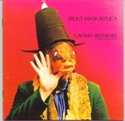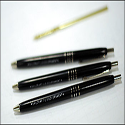|
Pukestain Pal posted:Are you studying for the Tech exam? I think there is only 1 or 2 questions involving q codes. Still good to know them though. Not sure what it's called in English, but I don't have a callsign yet so I think that's technician. I'm pretty much done modifying my NATO trainer for Q-codes, basically it picks a Q-code, then asks you either to pick the meaning or a proper reply from a list of four slightly random choices. When I learned the phonetic alphabet using a similar system (had to type the phonetic name) it took me about two days to learn it for good.
|
|
|
|

|
| # ? May 13, 2024 12:05 |
|
It's stupid that you don't need to know the phonetic alphabet to pass the test. It bothers the gently caress out of me when people make them up, and I have to sit there and think about what they're trying to spell. But then I did grow up on a boat talking to ships and stuff. And you NEED to use the correct phonetics for that, or they get in bad moods.
|
|
|
|
The phonetic alphabet is also far more useful in day to day life than Q-codes, unless you only talk to hams. I learned it properly when I took my maritime VHF certificate, but really I think it should be taught in middle school. Interestingly I don't think it was required to pass that test either, but it's highly recommended to be at least proficient.
|
|
|
|
Strictly speaking, only plain language should be used on voice modes, and Q-codes belong on morse code and slow speed digital modes (like PSK-31). For those in the US who get involved in emergency communications, they especially frown upon code use in the Incident Command System - that goes for both 10-codes and Q-codes. We hams still use some Q-codes as a sort of slang, but there's only a limited set that I've ever heard or used myself in voice QSOs or conversations: QRM, QRN, QRO, QRP, QRT, QRV, QRZ, QSO, QTH - and very rarely QSY and QRX. Vir fucked around with this message at 22:19 on Nov 13, 2012 |
|
|
|
I've never taken a marine VHF test, in the US you don't have to, but I've used it all over the world. And especially when you're talking to someone who's first language isn't english, it's critical you both use the same phonetics to get spellings across. Otherwise it's just a horrible mess. If you make them up, they might think you're saying a totally different word. But if you both stick to the same ones, you'll both be alright and get the info across. The point of radio is to convey information in the most efficient way possible, everybody using the same words to convey the same things is a great place to start. And I know this is a bit contradictory to the above, but. Q codes really annoy me, honestly. It doesn't take THAT much longer to just say it. There are so many drat Q codes it's hard to remember them all if you don't hear them all the time. Q codes belong in CW.
|
|
|
|
I agree, but the local hams seem to use a bit of slang and some phrases are on the test. Standard phrases are good since they make it easier to understand you on poor quality links but Q-codes seem almost counter productive. In maritime use you have several standard procedures but no special names or codes outside of securitè, pan pan and mayday. So my suggestion would be to drop Q-codes and instead make phonetic alphabet knowledge required.
|
|
|
|
I use standard phonetics and ICAO numbers. I say NINER instead of just nine, and FIFE instead of five since many people confuse five and nine on the air. With some foreign stations, even this doesn't help so learning to count in Spanish, Italian or the language of the DX country is a good tip. Also, some people don't say the standard phonetics in a standard way. I've heard operators say "eggre" instead of "ECKSray". Then it helps if they also give their call with some alternative phonetic, like Norway Xylophone Kentucy Honolulu, or Able Baker Dog etc., in addition to the standard phonetics.
|
|
|
|
Vir posted:I use standard phonetics and ICAO numbers. I say NINER instead of just nine, and FIFE instead of five since many people confuse five and nine on the air. With some foreign stations, even this doesn't help so learning to count in Spanish, Italian or the language of the DX country is a good tip. I never like alternate phonetics unless there's a communication issue. Its just confuses things. I know what November Xray Kilo Hotel means without even thinking about it. But when people start using random works like that, it takes me another second to parse what they're trying to say.
|
|
|
|
I typically use the alternate phonetics about one third or one fourth of the time when running on a frequency. It's true that it becomes just impossible if you use a different phonetic every time. longview: Vir fucked around with this message at 21:58 on Nov 13, 2012 |
|
|
|
We've already got a list of changes to the textbook, our teacher is pretty experienced. There are some changes that take effect in 2013, so we will apparently have to show how to calculate some basic EE stuff rather than just multiple choice. At least we don't have to learn morse.
|
|
|
|
Sounds good; to get everything correct on the old test you had to do those EE calcuations anyway. The new regulation had some consequences that some old-timers aren't aware of, like how 3rd party traffic - which used to not be allowed - is now allowed as long as the country of your counterpart allows it, and that D-Star voice is technically illegal in Norway (due to the AMBE encoding violating section 7). There were some frequency changes on November 1st too. I know some Norwegian clubs have started using fully online course materials in their training courses now.
|
|
|
|
Unless they want AC node analysis I think the EE stuff is well under control. What I have realized is that I don't know poo poo about antennas or antenna grounding however. I don't care for "simple" explanations of what is definitely a complicated situation, I know some transmission line theory and wave propagation is not unfamiliar, just not the realization of the antenna outside of "make a dipole, here's how" which did seem to work well for OTA TV.
|
|
|
|
I just renewed my US license for the first time. I was expecting it to be difficult since I know several sites charge for an "easy renew" program. The ULS form was easier than filling out billing info would've been. What a scam.
|
|
|
|
Vir posted:The new regulation had some consequences that some old-timers aren't aware of, like how 3rd party traffic - which used to not be allowed - is now allowed as long as the country of your counterpart allows it, and that D-Star voice is technically illegal in Norway (due to the AMBE encoding violating section 7). There were some frequency changes on November 1st too. As an Allstar Link node operator, a good compendium of these things would be a great reference to pass out to users. I manage the node, but, I'm not the repeater trustee. IF someone gets on and dials Norway, then autopatches me in, I'd be violating your rules and you'd have to disconnect then. (Well, I'm an op but you get it). It's up to whomever is operating to know what's going on, which, if myself or most of the people here are a good indictor, means that nobody knows nothing do whatever. The AMBE thing is sort of a pain since it's not really open, but, there are some options for that. I keep an eye on Codec2 but we don't have too many people in the area who would bother with it experimentally yet. D-Star died here, an agonizing death for the man who put up the D-Star repeater, but, alas, he found that we did not all have vaults of cash to spend on such things.
|
|
|
|
I said technically illegal. Our regulating authority hasn't cracked down on it (yet) and there are a few DSTAR-users in Norway still. As for third-party traffic, some sort of country matrix would be useful maybe (the challenge would be keeping it maintained). While Norway allows third-party traffic to all countries, we have to check if the other country allows it, and in some countries like the US they have a specific list of countries which Norway is not on. The US does allow third-party traffic for radio-amateurs who would be allowed to operate in the US though, and since Norwegian amateurs are covered by the CEPT agreement as Extra-class hams in the US, you could indeed send a radiogram to me from the US via amateur radio, but not to my unlicensed auntie for example. Vir fucked around with this message at 11:23 on Nov 15, 2012 |
|
|
|
Greybeards, I've finally bought my first HF rig! Kenwood TS-590, Astron power supply, Diamond SX-200 meter, and a 10-40m G5RV Jr. Now the stuff just needs to get here! Edit: meters not MHz dammit manero fucked around with this message at 03:29 on Nov 25, 2012 |
|
|
|
manero posted:Greybeards, I've finally bought my first HF rig! Nice! I finally got around to getting my FT-101 looked at. As it turns out, the no-power issue was fixed by removing the fuse and removing the bit of plastic that was stuck to the end of it. Apparently the ham who was trying to help me fix it last time pushed the fuse out of the plastic bag instead of cutting a hole in it. Anyway, we got it tuned up and had to move a few of the crystals into the correct spots, but it seems to work ok, putting out the full 80 watts on 160-20 meters, but for some reason it is only putting out 1 watt on 10 meters.
|
|
|
|
Anyone have any experience with the FlexRadio systems? I got my Canadian Basic w/Honours last fall, but outside of occasionally fiddling with an ICOM IC-92AD I picked up but never did much with, I haven't done much over the air. SDR looks like a very cool thing to get into, but it's hard to know where to start. I get computers, but the homebrew aspect of amateur radio that makes it so cool is also a high barrier to entry.
|
|
|
|
I'd look into a cheap SDR receiver before you drop a ton of money a serious transceiver like a Flex. SDRs are one of the few aspects of modern ham radio that still keep me intrigued, but there's a lot of setup. There's also no reason you can't use an SDR (and its broad waterfall display) to find signals, then use a traditional transmitter to reply either. If you want a really cheap toy to play with, look into the "RTL SDR" project where some clever folks have exploited sub-$30 USB TV tuner dongles as SDRs. I picked one up and it works surprisingly well considering the price. Tunes up UHF/VHF traffic like a charm.
|
|
|
|
manero posted:Greybeards, I've finally bought my first HF rig! Nice choice... I love mine and will probably never sell it. This is a nice website about the 590, has lots of how-tos: http://homepage.ntlworld.com/wadei/ts-590s.htm Follow the guide for adjusting your transmit audio on SSB very carefully, it's tricky to get it sounding well. Enjoy!
|
|
|
|
Is anyone interested in a Kenwood TH-D7A in perfect condition with the box, papers, case and PC cable? It has the AA battery pack. I figured I would ask here first before SAMart or Craigslist. Thinking around $300 shipped.
|
|
|
|
I've been looking at getting into ham radio for a little bit now. I live in bumfuck Alaska and having a secondary method of communication, especially when out hiking/hunting, would be pretty nice. Also I'm a police/fire/EMS dispatcher and my agency has some pretty nice ham gear that nobody knows how to use so it collects dust. I've decided on getting a handheld, but I'm having trouble figuring a something out. I'm looking at the Yaesu VX-7R or the Icom IC-91A. I want a handheld to throw in my pack and use in case of emergency, but the thing is the main rescue agency here is the US Coast Guard. Are either of these radios capable of transmitting on Marine VHF? I realize there are legal issues but it would only be in case of emergency, as in I need a helicopter ASAP. The Yaesu seems to be pretty well recommended, but we have a guy in town who can do warranty work on Icoms, since he does all the marine radio stuff for the fishing fleet. He may also work on Kenwood, but I'd have to check. SeamusMcPhisticuffs fucked around with this message at 09:00 on Dec 1, 2012 |
|
|
|
SeamusMcPhisticuffs posted:I've decided on getting a handheld, but I'm having trouble figuring a something out. I'm looking at the Yaesu VX-7R or the Icom IC-91A. I want a handheld to throw in my pack and use in case of emergency, but the thing is the main rescue agency here is the US Coast Guard. Are either of these radios capable of transmitting on Marine VHF? I realize there are legal issues but it would only be in case of emergency, as in I need a helicopter ASAP. To actually answer your question, I'm 99% certain the VX-7R can be opened up to use marine VHF frequencies. I assume the Icom can as well. SeamusMcPhisticuffs posted:The Yaesu seems to be pretty well recommended, but we have a guy in town who can do warranty work on Icoms, since he does all the marine radio stuff for the fishing fleet. He may also work on Kenwood, but I'd have to check.
|
|
|
|
SeamusMcPhisticuffs posted:I've been looking at getting into ham radio for a little bit now. I live in bumfuck Alaska and having a secondary method of communication, especially when out hiking/hunting, would be pretty nice. Also I'm a police/fire/EMS dispatcher and my agency has some pretty nice ham gear that nobody knows how to use so it collects dust. It's a little more expensive, but the Yaesu FT-817 was pretty much built for this. It's not quite as convenient a form factor as an HT. It is also probably about ten times more useful than one. Icom's old IC-703 is the same concept, but doesn't really have VHF beyond 6 meters, so it's out. If you could spare the pack space for the 817, a couple whips and a random wire, you could sleep pretty well at night in the back country.
|
|
|
|
Thanks for the info. The FT-817 looks awesome for moose camp, but is a bit big for out and about. Definitely adding it to my list though. Now I just have to figure out my actual budget.
|
|
|
|
The 817's smaller than you'd think. It's dense, but you can hold it in one hand. You won't be able to do much with it, but it's more portable than all the "enlarged to show texture" pictures on websites make it look.
|
|
|
|
Many handhelds can be opened up for general transmit - often by just cutting a resistor inside or by a software change; I see that there are mods posted online for both the IC-91 and VX-7R. Of course, actually using frequencies without a license should be limited to a life or death situation. Apparently there's a special Alaska emergency frequency at 5.1675 MHz http://www.law.cornell.edu/cfr/text/47/90.253 . If you get an HF radio like an FT-817ND, it should come opened up to that frequency, for safety of life communications only. You'll probably need a long antenna too, so yes it's mainly for camp. (Note that the FT-817ND has limited battery life with the factory supplied battery; a handheld with a Lithium Ion battery will have longer standby time, and the 817 is not waterproof.) As for the Coast Guard helicopters, don't they already have access to public saftey mutual aid frequencies and other land mobile frequencies on board? I would second the suggestion to get a Personal Locator Beacon. I have a McMurdo FastFind 220 GPS. Activating it takes just a few seconds, and can be done with one hand. Of course being able to communicate and give information is critical in many situations, as you already know, but in case you're incapacitated to the point that you can't speak or set up an antenna, or don't have time to try various frequencies, it could be a lifesaver. vvv: Correct, only on the US version though. Vir fucked around with this message at 23:43 on Dec 3, 2012 |
|
|
|
The 817 does have a software switch for toggling that frequency, iirc. It's been a while since I've even thought of the manual but I'm pretty sure it's there.
|
|
|
|
Yeah,it's got the Alaska freq in there. To be honest, my recommendation was based on the assumption that you may go pretty far out in the sticks, beyond any possible VHF/UHF coverage. If nobody's listening, your radio's no good. It's a bit of a gadget, I won't deny. But it is the smallest package in which you get a few watts of RF on HF, VHF and UHF. I would not complain if one fell in my lap, they seem pretty cool. Tangent: Anybody seen the IC-7100 yet? I love the design. Reminds me of old 70's sloped front console radios. And that is a touchscreen.  Jonny 290 fucked around with this message at 03:02 on Dec 6, 2012 |
|
|
|
drat, that looks good. Nice to see a base station that's not a huge morass of buttons, not to mention an adoption of a modern design philosophy with the touchscreen.
|
|
|
|
That looks like it owns! I would love to play with it. I just wonder what kind of filters it ships with - is it all digital? I gotta research.
|
|
|
|
Yeah, looks like it's got IF level DSP. Think of it as a pimped out IC-7000 base, pretty much. I'm pretty sure hardware filtering will be exclusive to high end/contesting rigs now. Certainly they always have porn shots of filter boards in the flagship radio brochures. Seen that Kenwood TS-990? Jesus.
|
|
|
|
That 990 looks awesome, but it's going to have to be a total home run since Icom and Yaesu have the "radio that costs more than some cars" market segment locked up. Rumor is that Bob Heil designed all of the audio, and that the radio will have a full IP stack with remote software built-in. The main receiver is all down conversion, and the sub-receiver is basically a TS-590S (mix of both.) I'll most likely eventually move from my TS-590 to the K3 line, but I hope one of the rich guys in my club buys a 990 so I can play with it. 
|
|
|
|
Jonny 290 posted:Tangent: Anybody seen the IC-7100 yet? I love the design. Reminds me of old 70's sloped front console radios. And that is a touchscreen.
|
|
|
|
Jonny 290 posted:Yeah, looks like it's got IF level DSP. Think of it as a pimped out IC-7000 base, pretty much. I'm pretty sure hardware filtering will be exclusive to high end/contesting rigs now. Also, Universal Radio is classing the 7100 as a successor to the IC-706 family, so I think it might be sold for less than $1000 (which would be amazing). Unfortunately, I'm willing to bet that it will come with a serial port and no standard Bluetooth (although they might offer a really buggy add-on board like Yaesu does).
|
|
|
|
I don't fully understand the idea behind software defined antennas, but why can't an antenna be constructed with several "rings" that either increase or decrease the electrical length of the antenna when moving between band depending on if a ring is on or not? As long as the antenna is long enough for it's lowest frequency wouldn't this allow it to adequately transmit on any higher frequency?
|
|
|
|
Hummer Driving human being posted:I don't fully understand the idea behind software defined antennas, but why can't an antenna be constructed with several "rings" that either increase or decrease the electrical length of the antenna when moving between band depending on if a ring is on or not? As long as the antenna is long enough for it's lowest frequency wouldn't this allow it to adequately transmit on any higher frequency?
|
|
|
|
nmfree posted:If I understand the wikipedia article correctly, something sort of like this already exists in the amateur world-- SteppIR antennas. I looked at that and see you manually crank something to change the length of the antenna. I was thinking more in the line of a signal is sent to the antenna, tells it what "ring" should be the highest based on the transmit frequency, and the signal is transmitted. Am I making any sense?
|
|
|
|
Hummer Driving human being posted:I looked at that and see you manually crank something to change the length of the antenna. I was thinking more in the line of a signal is sent to the antenna, tells it what "ring" should be the highest based on the transmit frequency, and the signal is transmitted. Am I making any sense? That's how modern cell-phone radio chips work. It's just complicated to have all those antenna bits everywhere so it makes for difficult RF engineering.
|
|
|
|

|
| # ? May 13, 2024 12:05 |
|
Hummer Driving human being posted:I looked at that and see you manually crank something to change the length of the antenna. I was thinking more in the line of a signal is sent to the antenna, tells it what "ring" should be the highest based on the transmit frequency, and the signal is transmitted. Am I making any sense? No, no, the CrankIr is just a side product. SteppIR is known for its wideband HF antennas that are tuned using stepper motors to extend or retract an element (hence the name). I always remembered their 43 foot vertical, but it looks like he did the yagi first: http://www.steppir.com/3-element-yagi If you want to spin this thing 180 degrees quickly, it's actually faster to hit a button (edit: 3 seconds quoted time) that readjusts the elements to the opposing lengths than it is to spin the rotator. Very cool antennas, pricey and controversial. I have often toyed with the idea of remotely tuned antennas of several types, and my latest thought is a dipole with a couple of relays that switch wire loops in and out of each side at the feedpoint. You could switch in a couple of differently sized loops - with 2 relays you could have four tuning options: 120 feet - no loops inline - about 3.9 MHz 124 feet - 2 foot loop per side - 3.75 MHz 127 feet - 3.5 foot loop per side - 3.65 MHz 131 feet - 2 and 3.5 foot loop per side - 3.55 MHz You'd have to fine tune it, but you get the idea. Jonny 290 fucked around with this message at 03:19 on Dec 7, 2012 |
|
|


























